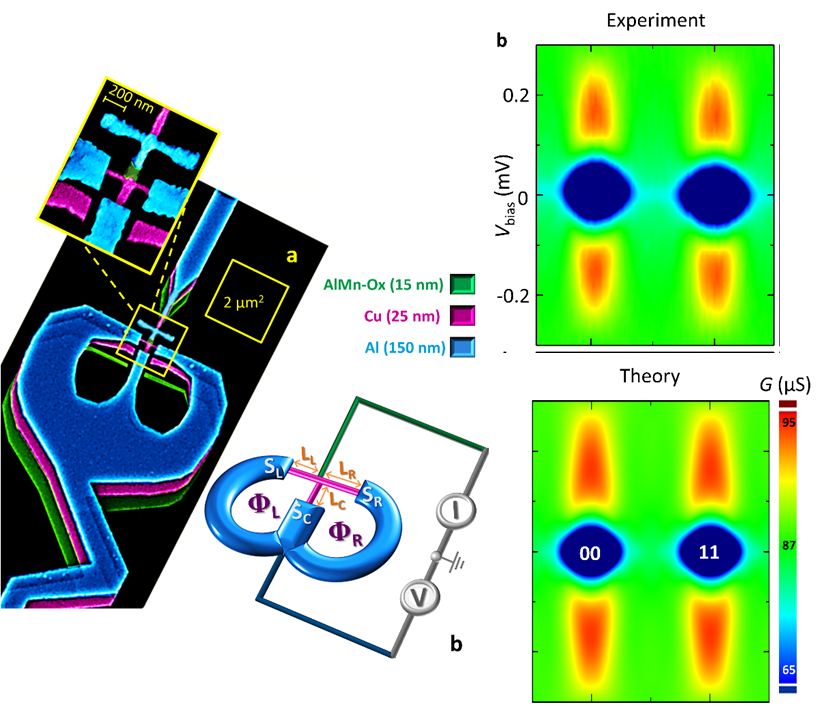

A. HYBRID AND TOPOLOGICALLY-PROTECTED SYSTEMS FOR SOLID-STATE QUANTUM TECHNOLOGY
1. Quantum transport and entanglement control in superconducting hybrid nanodevices.
Contact person:
Francesco Giazotto
The intrinsic entangled nature of electrons in Cooper pairs is used to generate non-local entanglement in nanowire-based Cooper pair splitters in which the degree and symmetry of the non-local entanglement can also be manipulated.
2. Control and detection of topological phases in hybrid superconductor-semiconductor systems.
Contact person:
Francesco Giazotto
Alessandro Braggio
The emergence of Majorana bound states (MBS) in semiconducting nanowires with strong spin-orbit coupling placed in close proximity to an s-wave superconductor is investigated by means of charge and heat quantum transport properties through normal-superconductor interfaces. Furthermore, a new class of artificial Josephson materials is investigated able to accommodate exotic topologies which support MBS or Weyl singularities.
|

|
|
InAs Nanowire Josephson junction showing a colossal enhancement of the supercurrent increasing the external magnetic field and ascribed to the formation of Majorana bound sates.
J. Tiira, E. Strambini, M. Amado, S. Roddaro, P. San-Jose, R. Aguado, F. S. Bergeret, D. Ercolani, L. Sorba, and F. Giazotto, Magnetically-driven colossal supercurrent enhancement in InAs nanowire Josephson juntions, Nature Comm, 8, 14984 (2017).
|
3. Superconducting spintronics.
Contact person:
Alberto Ghirri
Superconducting spintronics attempts to understand the interactions that arise when superconducting and magnetic order coexist.
4. Hybrid superconducting interferometers.
Contact person:
Francesco Giazotto
Alessandro Braggio
Superconducting quantum interferometers SQUID and SQUIPT are combined with different hybrid nanoscale systems, topological materials, and newly developed 2D materials.
|

|
|
The ω-SQUIPT, the first three terminal Josephson interferometer able to demonstrate the non-trivial topological states induced in a normal metal weak-link and controlled by an external magnetic field.
E. Strambini, S. D’Ambrosio, F. Vischi, F. S. Bergeret, Y. V. Nazarov, and F. Giazotto, The ω-SQUIPT as a tool to phase-engineer Josephson topological materials, Nature Nanotech, 11, 1055-1059 (2016)
|
5. Quantum transport in topological states of matter.
Contact person:
Stefan Heun
Matteo Carrega
The application of topologically-protected edge states, formed in the quantum Hall regime, to fault-tolerant quantum computation is investigated. In particular, we investigate the control of fractional components and detection schemes of anionic quasi-particles. Besides, we study hybrid superconducting junctions, with the goal to drive them into the quantum Hall regime, for the demonstration of the emergence of parafermions. Investigation of pseudomagnetic fields and edge modes in strain-engineered two-dimensional materials.
6. Single-photon counters exploiting metamaterials and single electron states in quantum nanostructures.
Contact person:
Miriam Vitiello
Planar-metamaterial resonators are used to innovatively enable efficient single photon detection in the infrared, especially in the Terahertz frequency range.
7. Control of single-photons in nanofiber networks.
Contact person:
Andrea Camposeo
Luana Persano
The aim is to develop a hybrid single-photon light source architecture, based on isolated quantum nano-emitters embedded in the core of polymer nanofibres.
8. Hybrid photon-spin systems based on high-Tc superconducting circuits as quantum bus.
Contact person:
Marco Affronte
Alberto Ghirri
Challenge tackled by using high Tc superconducting planar resonators are: i) to couple different type of quantum registers and memories including semiconducting quantum dots or molecular spin centers; ii) to address single solid state qubits and to coherently couple remote qubits through a superconducting quantum bus; iii) to implement pulsed microwave technology for the coherent manipulation and read-out of solid state spin qubits.
|

|
|
Pictorial representation of a vanadylphtalocyanine spin ensemble coupled to a high-TcsuperconductingYBCO/sapphire coplanar resonator.
C. Bonizzoni, A. Ghirri, K. Bader, J. Van Slageren, M. Perfetti, L. Sorace, Y. Lan, O. Fuhr, M. Ruben, and M. Affronte Coupling molecular spin centers to microwave planar resonators: towards integration of molecular qubits in quantum circuits, Dalton Trans, 45, 16596 (2016)
|
|

|
|
Transmission spectroscopy of molecular spin ensembles coupled to a YBCO/sapphire coplanar resonator.
C. Bonizzoni, A. Ghirri, M. Atzori, L. Sorace, R. Sessoli, and M. Affronte Coherent coupling between Vanadyl Phthalocyanine spin ensemble and microwave photons: towards integration of molecular spin qubits into quantum circuits, Sci. Rep., 7, 13096 (2017)
A. Ghirri, C. Bonizzoni, F. Troiani, N. Buccheri, L. Beverina, A. Cassinese, and M. Affronte Coherently coupling distinct spin ensembles through a high-Tc superconducting resonator, Phys. Rev. A, 93, 063855 (2016)
|
9. Identification and exploitation of intrinsically protected spin degrees of freedom within molecular nanomagnets, such as spin chirality.
Contact person:
Marco Affronte
Alberto Ghirri
Besides the robustness, these are amenable to electric-field (rather than magnetic-field) manipulation.
|